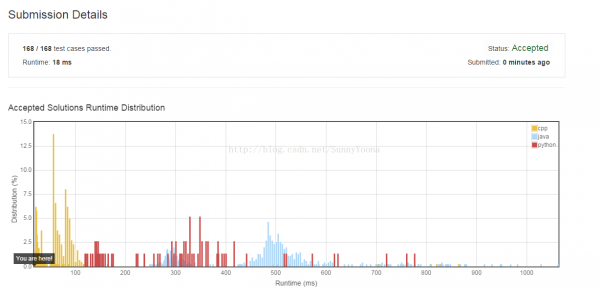[LeetCode]56.Merge Intervals
栏目:php教程时间:2015-02-13 08:19:31
【题目】
Given a collection of intervals, merge all overlapping intervals.
For example,
Given [1,3],[2,6],[8,10],[15,18],
return [1,6],[8,10],[15,18].
【分析】
(1)先将目标区间数组按X轴从小到大排序。例如:[2,3] [1,2] [3,9] ->[1,2] [2,3] [3,9]
(2)扫描排序后的目标区间数组,将这些区间合并成若干个互不相交的区间。例如 [2,3] [1,2] [4,9] ->[1,3] [4,9]
这里分3种情况:
a:[1,3] [2,6] -> [1,6] 第1个区间的end大于等于第2个区间的start,同时第2个区间的end大于第1个区间的end
b:[1,7] [2,4] -> [1,7] 第1个区间的end大于等于第2个区间的start,同时第2个区间的end小于第1个区间的end
c:[1,2] [3,4] -> [1,2] [3,4] 第1个区间的end小于第2个区间的start
【代码】
/*********************************
* 日期:2015-01⑴4
* 作者:SJF0115
* 题目: 56.Merge Intervals
* 网址:https://oj.leetcode.com/problems/merge-intervals/
* 结果:AC
* 来源:LeetCode
* 博客:
**********************************/
#include <iostream>
#include <algorithm>
#include <vector>
using namespace std;
struct Interval {
int start;
int end;
Interval() : start(0), end(0) {}
Interval(int s, int e) : start(s), end(e) {}
};
class Solution {
public:
// 比较函数
static bool cmp(const Interval& ina,const Interval& inb){
return ina.start < inb.start;
}
vector<Interval> merge(vector<Interval> &intervals) {
vector<Interval> result;
int count = intervals.size();
if(count <= 1){
return intervals;
}//if
// x轴排序
sort(intervals.begin(),intervals.end(),cmp);
// 合并
result.push_back(intervals[0]);
// 斟酌3种情况
for(int i = 1;i < count;i++){
Interval preIn = result.back();
Interval curIn = intervals[i];
// [1,3] [2,6]
if(curIn.start <= preIn.end && curIn.end > preIn.end){
preIn.end = curIn.end;
result.pop_back();
result.push_back(preIn);
}//if
// [1,2] [3,4]
else if(curIn.start > preIn.end){
result.push_back(curIn);
}
// [1,7] [2,3] 不用做任何事
}//for
return result;
}
};
int main(){
Solution solution;
Interval in1(1,2);
Interval in2(4,6);
Interval in3(8,10);
Interval in4(15,18);
vector<Interval> vec;
vec.push_back(in1);
vec.push_back(in2);
vec.push_back(in3);
vec.push_back(in4);
// 合并
vector<Interval> v = solution.merge(vec);
// 输出
for(int i = 0;i < v.size();i++){
Interval in = v[i];
cout<<"["<<in.start<<","<<in.end<<"]"<<endl;
}//for
return 0;
}

------分隔线----------------------------
------分隔线----------------------------